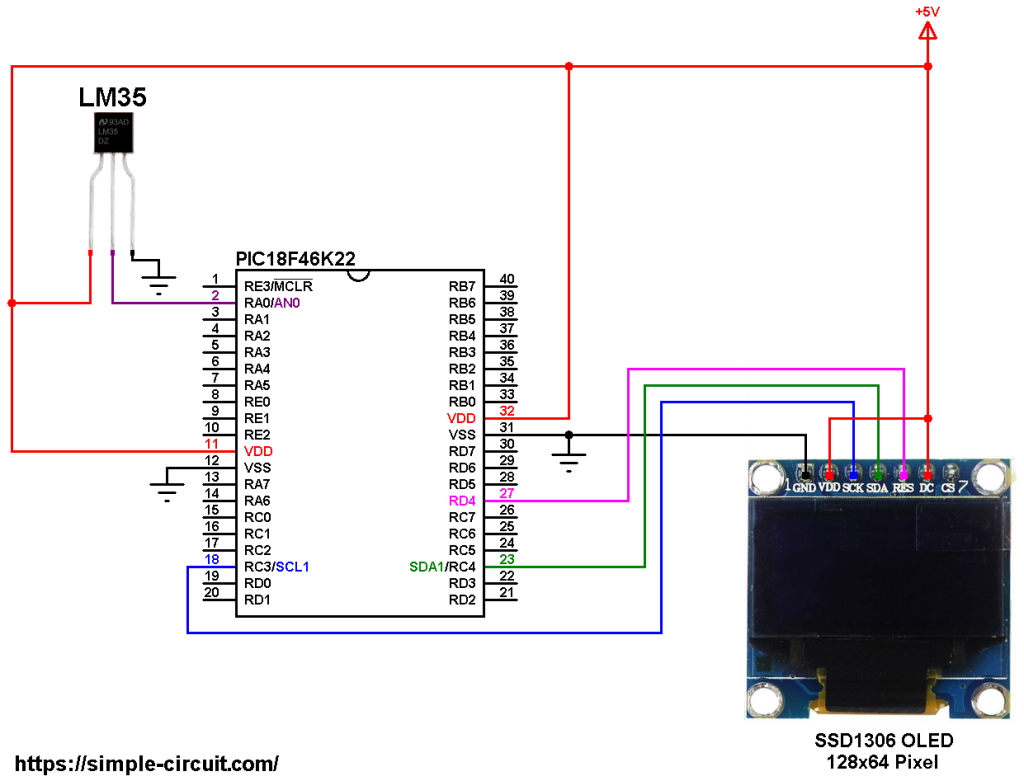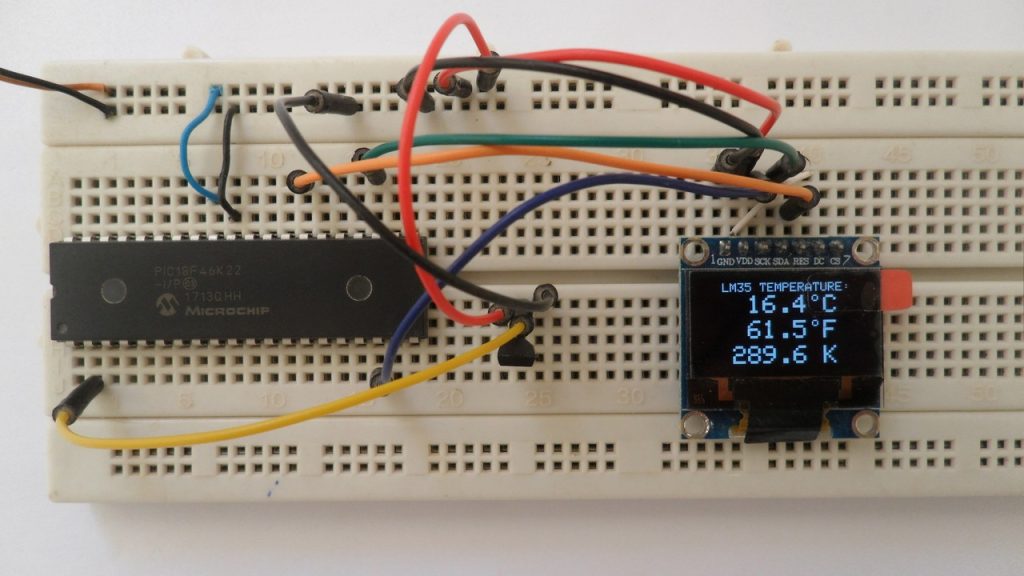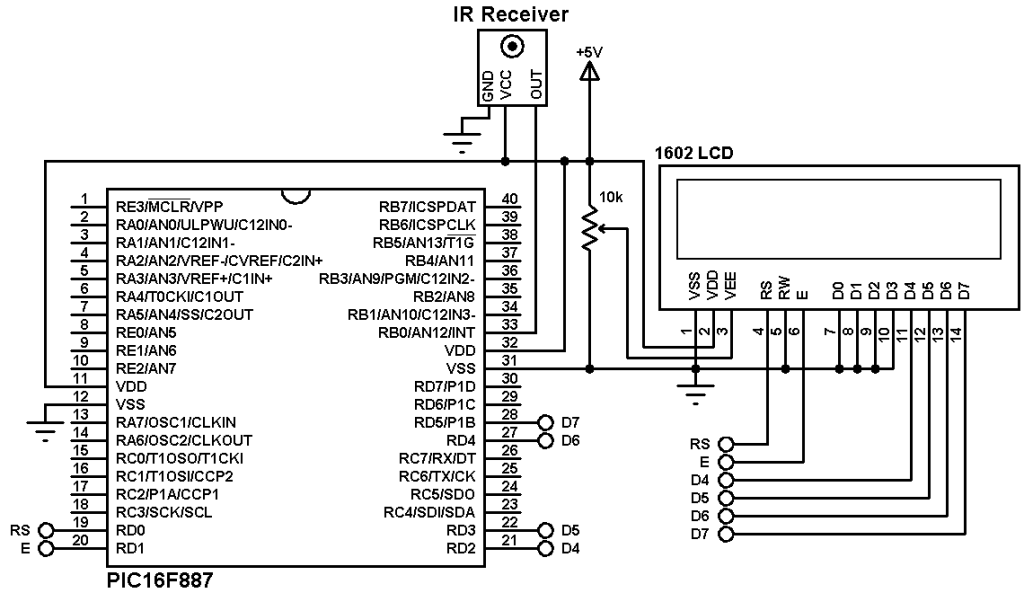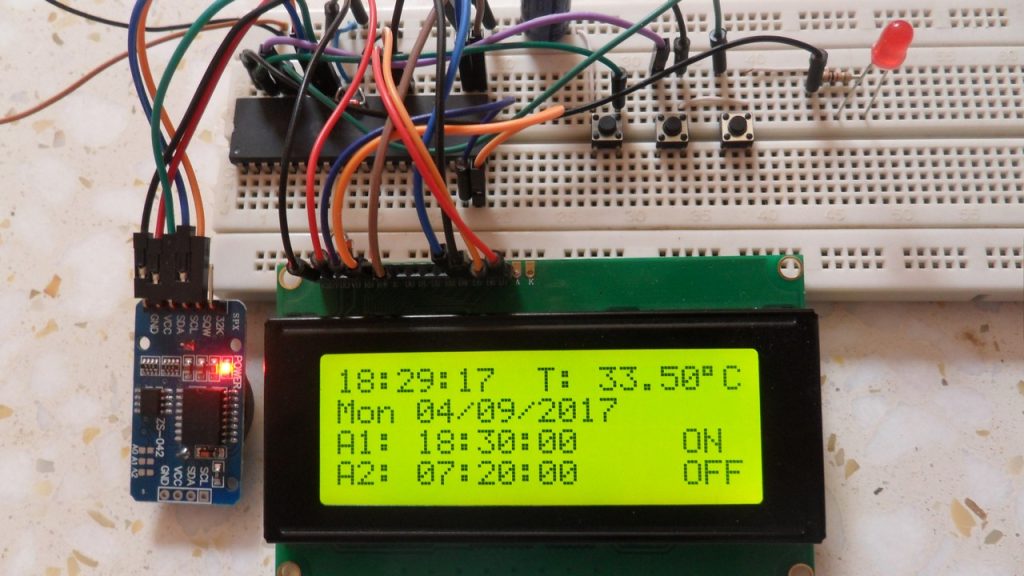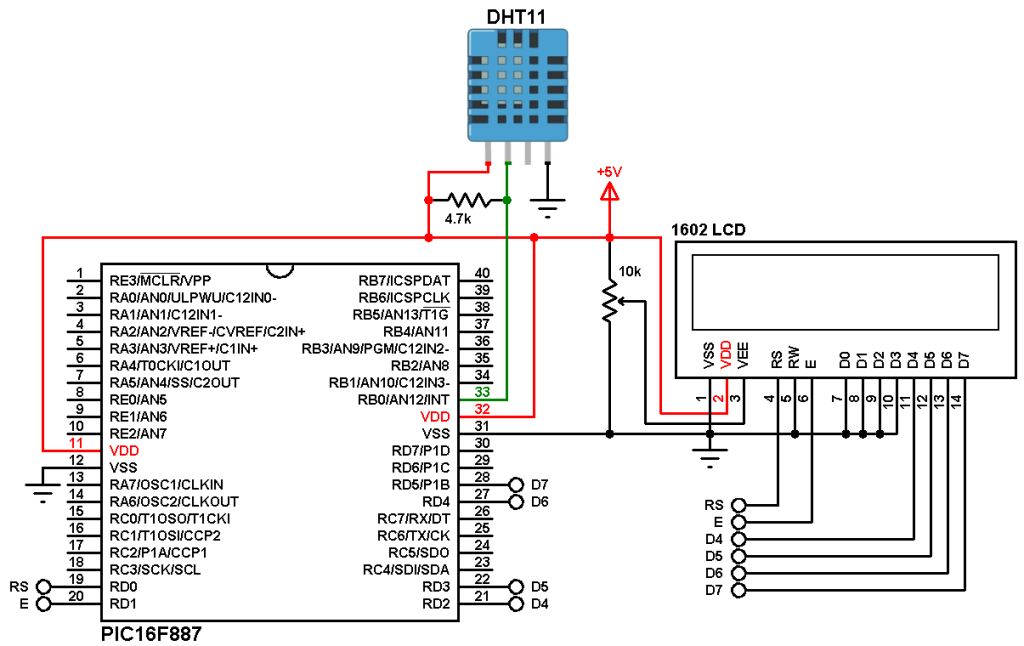This tutorial shows how to interface PIC18F46K22 microcontroller with SSD1306 OLED display and LM35 analog temperature sensor.
In this project the SSD1306 OLED display (128×64 pixel) is used to display environment temperature in degree Celsius, Kelvin and degree Fahrenheit.
MikroC PRO for PIC compiler is used in this project.
The LM35 temperature sensor is a three pin device (VCC, OUT and GND) with an output voltage linearly related to Centigrade temperature. Since the LM35 output varies with dependent to the temperature, we need an ADC (Analog-to-Digital Converter) module to measure this voltage. The PIC18F46K22 microcontroller has one ADC module with 10-bit resolution.
The LM35 output has linear +10mV/°C scale factor means the following:
If the output voltage = 10mV —> temperature = 1°C
If the output voltage = 100mV —> temperature = 10°C
If the output voltage = 200mV —> temperature = 20°C
If the output voltage = 370mV —> temperature = 37°C
and so on.
To see how to interface PIC18F46K22 microcontroller with LM35 sensor, visit the following post:
Interfacing PIC18F46K22 with 7-segment display and LM35 sensor
And to see how to interface PIC18F46K22 MCU with SSD1306 OLED display, take a look at the following project:
Interfacing PIC18F46K22 with SSD1306 OLED display | mikroC Projects
Hardware Required:
- PIC18F46K22 microcontroller —-> datasheet
- SSD1306 OLED display
- LM35 temperature sensor —-> datasheet
- 5V source
- Breadboard
- Jumper wires
PIC18F46K22 with SSD1306 OLED and LM35 circuit:
The image below shows project circuit diagram.
All the grounded terminals are connected together.
The LM35 sensor has 3 pins (from left to right):
Pin 1 is power supply pin, connected to circuit +5V
Pin 2: output pin
Pin 3: GND (ground), connected to circuit ground.
The output pin of the LM35 sensor is connected to pin RA0 which is analog channel 0 (AN0).
The PIC18F46K22 microcontroller has 2 hardware I2C modules (MSSP1 and MSSP2 modules).
In this project I2C1 module is used with SDA1 on pin RC4 (#23) and SCL1 on pin RC3 (#18). The SDA1 pin of the MCU is connected to the SDA pin of the display and the SCL1 pin of the MCU is connected to the SCL pin of the display.
The reset pin of the display is connected to pin RD4 (#27) of the microcontroller.
The SSD1306 OLED display DC pin is connected to VDD which means I2C slave address of the device is 0x7A.
In this project the PIC18F46K22 microcontroller runs with its internal oscillator @ 16 MHz, MCLR pin is configured as an input pin.
PIC18F46K22 with LM335 and SSD1306 OLED C code:
The following C code is for mikroC PRO for PIC compiler, it was tested with version 7.2.0.
To be able to compile the C code below with no error, a driver for the SSD1306 OLED display is required, its full name (with extension) is SSD1306OLED.C, download link is the one below:
SSD1306 OLED mikroC library
for more information about this driver, visit the following post:
SSD1306 OLED display library for mikroC compiler | mikroC Projects
after the download, add the driver file to mikroC project folder.
The ADC module is configured so that it uses its internal clock, voltage references (negative and positive) are set to VSS and FVR respectively where the FVR is set to 1.024V:
1 2 | // initialize ADC module with voltage references: VSS - FVR(1.024V) ADC_Init_Advanced(_ADC_INTERNAL_VREFL | _ADC_INTERNAL_FVRH1); |
PIC18F46K22 ADC module is used with 10-bit resolution which means the digital value of the input analog voltage varies between 0 (0V) and 1023 (1.024V).
The digital value represents the temperature in tenths °Celsius (output value of “274” equals 27.4 °Celsius).
The temperature in tenths degree Fahrenheit = (tenth °Celsius) x 9/5 +320 (because: °F = °Cx9/5 + 32) and the temperature in tenths Kelvin = (tenth °Celsius) + 2732 (because: K = °C + 273.16).
To get the actual value of each quantity we’ve to divide it by 10. The line below shows an example for temperature in Kelvin:
1 | sprinti(buffer, "%03u.%1u K", tKelvin / 10, tKelvin % 10); |
We get the first 3 digits by dividing the tenths value by 10, and the tenths number (number after the decimal point) of the actual temperature value is equal to the reminder of that division (tenths value % 10).
The resolution of this thermometer is 0.1°C.
Full mikroC code:
1 2 3 4 5 6 7 8 9 10 11 12 13 14 15 16 17 18 19 20 21 22 23 24 25 26 27 28 29 30 31 32 33 34 35 36 37 38 39 40 41 42 43 44 45 46 47 48 49 50 51 52 53 54 55 56 57 58 59 60 61 62 63 64 65 66 67 68 69 70 71 72 73 74 75 76 77 78 79 80 81 82 83 84 85 86 87 88 89 90 91 92 | /************************************************************************************** Interfacing PIC18F46K22 microcontroller with SSD1306 OLED (128x64 Pixel) and LM35 analog temperature sensor. C Code for mikroC PRO for PIC compiler. Internal oscillator used @ 16MHz Configuration words: CONFIG1H = 0x0028 CONFIG2L = 0x0018 CONFIG2H = 0x003C CONFIG3H = 0x0037 CONFIG4L = 0x0081 CONFIG5L = 0x000F CONFIG5H = 0x00C0 CONFIG6L = 0x000F CONFIG6H = 0x00E0 CONFIG7L = 0x000F CONFIG7H = 0x0040 This is a free software with NO WARRANTY. http://simple-circuit.com/ ***************************************************************************************/ // SSD1306 OLED reset pin definition (if available) #define SSD1306_RST RD4_bit #define SSD1306_RST_DIR TRISD4_bit #include <SSD1306OLED.c> // include SSD1306 OLED display driver source code // main function void main() { OSCCON = 0x70; // set internal oscillator to 16MHz ANSELC = 0; // configure all PORTC pins as digital ANSELD = 0; // configure all PORTD pins as digital // initialize ADC module with voltage references: VSS - FVR(1.024V) ADC_Init_Advanced(_ADC_INTERNAL_VREFL | _ADC_INTERNAL_FVRH1); I2C1_Init(400000); // initialize I2C communication with clock frequency of 400kHz delay_ms(1000); // wait a second // initialize the SSD1306 OLED with an I2C addr = 0x7A (default address) SSD1306_Begin(SSD1306_SWITCHCAPVCC, SSD1306_I2C_ADDRESS); SSD1306_ClearDisplay(); // clear the display buffer SSD1306_GotoXY(15, 0); // move cursor to position (15, 0) pixel SSD1306_Print("LM35 TEMPERATURE:"); // print text SSD1306_Display(); // update the display SSD1306_TextSize(2); // set text size to 2 while(1) { int tKelvin, tCelsius, tFahrenheit; char buffer[8]; // read analog voltage ( = tenths degree Celsius) tCelsius = ADC_Get_Sample(0); tKelvin = tCelsius + 2732; // convert °C to Kelvin tFahrenheit = tCelsius * 9/5 + 320 ; // convert °C to Fahrenheit // print temperature in degree Celsius if (tCelsius >= 1000) // if temperature >= 100.0 °C sprinti(buffer, "%03u.%1u C", tCelsius / 10, tCelsius % 10); else sprinti(buffer, " %02u.%1u C", tCelsius / 10, tCelsius % 10); SSD1306_GotoXY(23, 10); SSD1306_Print(buffer); SSD1306_Color = true; // set screen color // print temperature in degree Fahrenheit if (tFahrenheit >= 1000) // if temperature >= 100.0 °F sprinti(buffer, "%03u.%1u F", tFahrenheit / 10, tFahrenheit % 10); else sprinti(buffer, " %02u.%1u F", tFahrenheit / 10, tFahrenheit % 10); SSD1306_GotoXY(23, 30); SSD1306_Print(buffer); // print temperature in Kelvin sprinti(buffer, "%03u.%1u K", tKelvin / 10, tKelvin % 10); SSD1306_GotoXY(23, 50); SSD1306_Print(buffer); // print degree symblos ( ° ) SSD1306_Color = true; // set screen color SSD1306_DrawCircle(88, 12, 2); SSD1306_DrawCircle(88, 32, 2); SSD1306_Display(); // update the display delay_ms(1000); // wait a second } } // end of code. |
Discover more from Simple Circuit
Subscribe to get the latest posts sent to your email.
